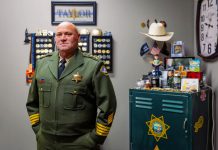Hollister
– In what experts say is a crucial step to ensuring that the
California condor begins to flourish again, two of the endangered
birds released through the Pinnacles National Monument Condor
Recovery Program made contact with a flock in Big Sur this
month.
Hollister – In what experts say is a crucial step to ensuring that the California condor begins to flourish again, two of the endangered birds released through the Pinnacles National Monument Condor Recovery Program made contact with a flock in Big Sur this month.
“This is an exciting milestone that has taken place,” said Jim Petterson, park supervisor and wildlife biologist.
The occasion is bittersweet, however, as monument officials recently discovered that up to 11 of the Pinnacles’ 19 condors could potentially be suffering from lead poisoning – a condition that could prove fatal if the birds are not treated within a few weeks.
“We’re making a frantic effort to trap the birds,” said Petterson. “They could become paralyzed and die within two weeks if they don’t receive the proper treatment.”
Since 2003, 19 birds have been released from the Pinnacles, where staff have monitored their progress and ensured their safety from tourists, hunters and the elements. June 7 marked the first time, however, that any of the birds had a chance to interact with condors from outside the park.
“We don’t know for sure that this has never happened before,” said Petterson. “But it is the first time we’ve ever documented it happening.”
In Big Sur, where condor recovery has been taking place since the late 1980s, the population is substantially larger than that at the Pinnacles, and many of the birds are older than the 3-year-old condors that paid them a visit last week.
“Usually condors are pretty aggressive, and the older birds in particular can be very possessive of their food,” said Petterson. “But these two were able to hold their own and feed with the others, so that’s a really good sign.”
The condors’ meeting is good news, because it means that more birds from Pinnacles might start spending more time in Big Sur, and vice versa. Many of the Big Sur condors already spend time at another condor habitat just north of Ventura, and birds from the Pinnacles might be encouraged to head south as well.
“When these ones are old enough to begin mating, there’s a chance that they might mix with the ones from Big Sur,” said Petterson. “And you’ll have greater genetic diversity.”
As the condors branch out from the Pinnacles, however, there are dangers that threaten the birds’ continued success in the wild. Due to the spring weather, ground squirrels and other small rodents are infesting private property near the Monument. Landowners are hunting the rodents to keep from being overrun with furry pests.
Condors are scavengers and feed almost exclusively off carrion. Lead fragments from bullets left in a rodent carcass can poison and kill the birds. So far monument staff have not witnessed any condors behaving as though they are ill, but because they roam free it will be all but impossible to know until experts have a chance to look at the birds up close.
“If we can catch them, we’ll know whether or not to send them to the L.A. Zoo for treatment,” said Petterson.
Pinnacles officials have asked nearby hunters to use copper ammunition, which does not break into small pieces, as opposed to lead, and have links on the Monument Web site to vendors that will supply it. However, no copper ammo is available for a gun as small as a .22 caliber rifle, which most people use to kill small creatures like squirrels. Officials are hopeful such a product will be available shortly.
“It’s a classic Catch-22,” said Petterson. “We’re asking them to use copper ammunition, but if they don’t make it that small, then what can you do?”
Petterson suggests that people bury any animals they shoot, or remove them in a plastic bag, instead of leaving the carcasses out for condors to pick at.
“Everyone I’ve talked to has been very excited about the condors and about seeing them on their property,” he said. “We just need to make sure they’re not being poisoned.”
Pinnacles staff are hoping to offer a program in the future that would supply hunters with low or no-cost copper ammunition.
Danielle Smith covers education for the Free Lance. Reach her at 637-5566, ext. 336 or ds****@***********ws.com









